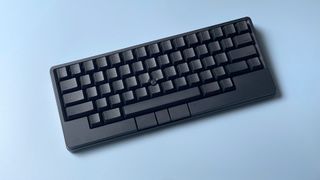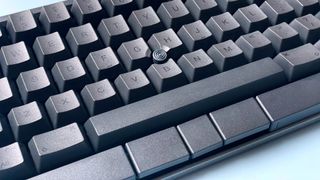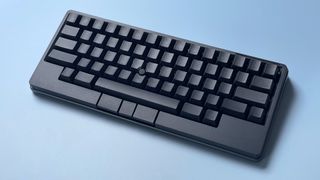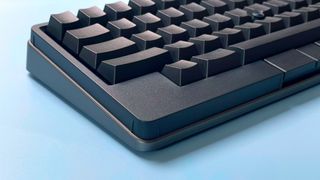HHKB
Studio:
Two-minute
review
Happy
Hacking
Keyboard
(HHKB)
is
known
for
its
quirky,
niche
devices
that
appeal
to
a
small,
dedicated
band
of
enthusiasts.
The
HHKB
Studio
doesn’t
break
that
trend
but
instead
leans
into
it
hard,
and
it’s
a
keyboard
that
you’re
either
going
to
love
or
hate.
At
£325,
the
stakes
are
high.
Before
we
get
into
the
quirks,
let’s
talk
about
the
more
down-to-earth
aspects.
For
one
thing,
the
typing
feel
of
the
Studio
is
absolutely
beautiful.
I’m
not
usually
a
fan
of
linear
switches,
but
those
in
the
Studio
are
smooth
and
responsive,
with
what
feels
like
an
almost
perfect
degree
of
travel.
There’s
no
bottoming
out
here.
They
also
sound
lovely
and
quiet
in
use,
with
the
one
exception
of
the
space
bar,
which
is
unmistakably
clunky
when
pressed.
The
Studio’s
linear
switches
are
hot-swappable,
and
HHKB
has
made
the
PCB
compatible
with
both
three-pin
and
five-pin
MX
switches,
giving
you
a
huge
range
of
options
(although
in
doing
so
it
has
given
up
the
Topre
switches
loved
by
so
many
HHKB
fans).
The
PBT
keycaps
are
also
notably
thick,
adding
to
the
exceptional
typing
feel.
The
PBT
material
means
there’s
no
shine-through
backlighting,
though.
HHKB’s
Keymap
Tool
app
is
solid,
and
it
lets
you
remap
keys,
create
profiles,
change
the
functions
of
the
gesture
pads
(I’ll
get
to
those
later),
and
more.
The
chassis,
meanwhile,
is
hefty
and
fairly
weighty,
with
thick
plastic
around
every
surface.
It
is
a
little
rattly
when
you
put
it
down,
though,
and
this
seems
to
be
mostly
due
to
the
board’s
flip-out
feet.

(Image
credit:
Future)
OK,
enough
about
the
conventional
aspects
of
the
Studio.
What
about
the
more
“eclectic”
stuff?
Well,
the
Studio
is
designed
to
be
an
all-in-one
device
that
acts
not
only
as
a
keyboard,
but
as
a
mouse,
too.
It
comes
with
a
“pointing
stick”
nubbin
nestled
between
the
G,
H,
and
B
keys.
Nudge
it
in
any
direction
and
your
mouse
pointer
follows.
Below
the
space
bar
are
three
keys:
left
and
right
mouse
buttons,
plus
a
middle
button
that
acts
as
a
modifier
key
(hold
it
and
move
the
nubbin
to
scroll
a
web
page,
for
instance).
This
substitute
mouse
arrangement
is
fine,
but
it
never
grabbed
me
as
something
totally
essential,
and
it
can’t
beat
the
control
you
get
from
a
standalone
mouse.
On
the
bottom
and
side
edges
of
the
Studio
are
four
gesture
strips.
These
can
be
customized,
but
by
default
they
move
the
cursor
up
and
down
(left
strip),
move
the
cursor
left
and
right
(bottom-left
strip),
switch
app
windows
(bottom-right
strip),
and
scroll
windows
and
web
pages
(right
strip).
These
are
fiddly
and
unintuitive,
and
I
only
used
them
begrudgingly.
At
times
I
had
no
choice,
though,
because
the
Studio
lacks
arrow
keys
in
an
effort
to
make
it
more
compact.
Unfortunately,
the
gesture
strips
are
far
fiddlier
and
less
accurate
than
simply
tapping
an
arrow
key
would
be.
If
I
needed
to
move
the
cursor
when
typing
up
a
document,
I
often
found
it
was
quicker
to
just
click
to
reposition,
rather
than
trying
to
get
the
gesture
strip
to
move
the
cursor
to
the
right
place.

The
pointer
stick
and
built-in
buttons
at
the
bottom
of
the
HHKB
Studio
are
intended
to
replace
your
mouse.
(Image
credit:
Future)
Things
like
this
undeniably
feel
like
solutions
to
problems
that
HHKB
itself
has
created.
If
you
don’t
remove
the
arrow
keys,
for
example,
then
there’s
no
need
for
the
finicky,
over-engineered
gesture
strips.
Arrow
keys
do
not
feel
like
much
of
a
problem
unless
you
really
want
the
most
compact
keyboard
imaginable,
but
even
then,
I’m
not
sure
that
the
Studio’s
answer
is
the
correct
one.
Some
of
the
other
design
choices
are
a
little
baffling.
The
Control
key
has
been
removed
and
instead
replaces
the
Caps
Lock
key
for
seemingly
no
other
reason
than
that
this
makes
the
layout
more
symmetrical,
but
it
means
another
interruption
of
your
muscle
memory.
The
decision
to
make
the
key
legends
incredibly
faint,
meanwhile,
makes
them
almost
impossible
to
see
in
every
lighting
condition.
By
default,
the
backspace
key
(which
normally
removes
the
character
to
the
left
of
the
cursor)
actually
performs
the
delete
function
(removing
the
character
to
the
right
of
the
cursor)
on
both
Windows
and
macOS
layouts.
You
can
change
this
by
flipping
a
switch
hidden
under
the
battery
cover,
but
the
default
setting
runs
counter
to
the
key’s
regular
way
of
working
(and
your
muscle
memory).
HHKB
says
you
can’t
change
this
in
macOS
but,
much
to
my
relief,
I
had
no
trouble
doing
so,
other
than
having
to
turn
the
keyboard
off
and
on
again
for
the
change
to
come
into
effect.
If
you
can
accept
all
the
eccentricities,
the
HHKB
Studio
offers
a
highly
satisfying
typing
experience
that
is
almost
infinitely
customizable.
But
if
you
don’t
need
the
mouse
nubbin
and
gesture
control
strips
–
or
don’t
like
the
faint
keycaps
and
repositioned
buttons
–
£325
is
an
eye-wateringly
high
price
to
pay.
HHKB
Studio:
Price
and
availability

(Image
credit:
Future)
The
HHKB
Studio
costs
£325.
That’s
very
expensive
for
a
keyboard,
even
for
the
vast
majority
of
our
picks
for
the
best
keyboards
on
the
market.
You
should
be
sure
you
need
all
of
the
HHKB
Studio’s
features
before
pulling
the
trigger.
Should
you
buy
the
HHKB
Studio?

The
raised
plastic
edges
(the
top,
darker
areas
on
the
side
and
bottom
of
the
keyboard)
contain
touch-sensitive
strips.
They’re
a
bit
fiddly
to
use,
though.
(Image
credit:
Future)
to
scroll
horizontally
|
Value |
Some will gladly pay for its specialized feature set, but the price is too high for most. |
2 / 5 |
|
Design |
The sturdy chassis and thick PBT keycaps win our approval, but there are small missteps, like the rattly space bar and flip-out feet. |
3.5 / 5 |
|
Performance |
The Studio offers a superb, quiet typing experience. It works with Windows and macOS, connects to four devices, and its software makes it highly customizable. |
5 / 5 |
|
Average rating |
Brilliant at the basics, but full of strange quirks. |
3.5 / 5 |
Buy
it
if…
Don’t
buy
it
if…
HHKB
Studio:
Also
consider
Looking
elsewhere?
Give
these
keyboards
some
thought…
How
I
tested
the
HHKB
Studio
I
tested
the
HHKB
Studio
for
a
few
weeks
by
spending
time
typing
articles,
browsing
the
web,
and
generally
using
my
computer.
I
assessed
it
its
compatibility
in
both
Windows
and
macOS.
As
well
as
that,
I
ran
the
companion
Keymap
Tool
app
through
its
paces.
-
First
reviewed
September
2024
